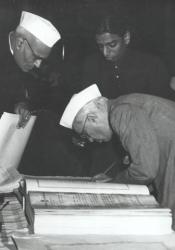Indian Government Outlaws Caste System
The Indian government outlawed discrimination on the basis of caste in 1948, after decades of movements and protests. This ratification became part of an amendment to the Indian constitution, with article 15 prohibiting discrimination based on caste and Article 17 declaring the practice of untouchability to be illegal.
The anti-caste Dalit movement began with Jyotirao Phule in the mid-19th century, who worked to abolish the idea of “untouchability”. Figures such as B.R. Ambedkar and Gandhi also became prominent through advocacy for the abolishment of the caste system. Ambedkar campaigned for greater rights for Dalits in British India beginning in the 1920s and 30s, continuing even after independence in 1947, and during the national movement, Gandhi began using the term “Harijans” (God’s people) to refer to the untouchable class. He believed it to be a moral issue that could be abolished through goodwill among Hindus of the upper-caste.
In 1935, the British Government of India came up with a list of 400 groups considered untouchable, including many native tribes, that would be afforded special privileges in order to combat historical discrimination. The groups included on this list became known as the Scheduled Castes and Scheduled Tribes in the affirmative action plan established by the government. The Scheduled Castes are comprised of communities considered to be of the lowest in the social hierarchy, and the Scheduled Tribes include those communities who rejected the caste system in favor of living isolated from society in the jungles, forests, and mountains of India. These groups are eligible for preferential policies with reserved seats in legislatures, government jobs, public sector enterprises, and state-supervised educational institutions. Unfortunately, however, only a relatively small proportion of the lower castes have benefited from these preferential policies due to continued hostility and violence against the lower class in many parts of India even today.
Image Source: “Jawaharlal Nehru Signing the Indian Constitution, in 1950.” Wikimedia Commons, 3 Aug. 2020, https://commons.wikimedia.org/wiki/File:Jawaharlal_Nehru_signing_the_Ind.... Accessed 10 Nov. 2021.
Deshpande, Manali S. “History of the Indian Caste System and Its Impact on India Today.” California Polytechnic State University, 2010.
Kositsky, Sasha Riser. “The Political Intensification of Caste: India Under the Raj .” Penn History Review , vol. 17, no. 1, Dec. 2009, https://repository.upenn.edu/cgi/viewcontent.cgi?article=1012&context=phr. Accessed 10 Nov. 2021.
Mishra, Neha. “India and Colorism: The Finer Nuances .” Washington University Global Studies Law Review , vol. 14, no. 4, 2015, https://openscholarship.wustl.edu/cgi/viewcontent.cgi?article=1553&conte.... Accessed 10 Nov. 2021.
Olcott, Mason. “The Caste System of India.” American Sociological Review, vol. 9, no. 6, Dec. 1944, pp. 648–657., https://www.jstor.org/stable/2085128?origin=crossref&seq=1#metadata_info....
Ramesh, Kamboju. “Caste System and Political Change in Indian Democracy – A Study.” International Journal of Creative Research Thoughts , vol. 8, no. 11, Nov. 2020, https://www.ijcrt.org/papers/IJCRT2011075.pdf. Accessed 10 Nov. 2021.

